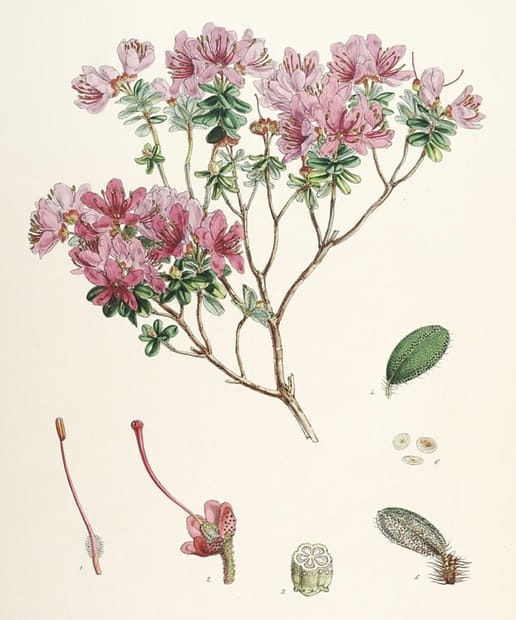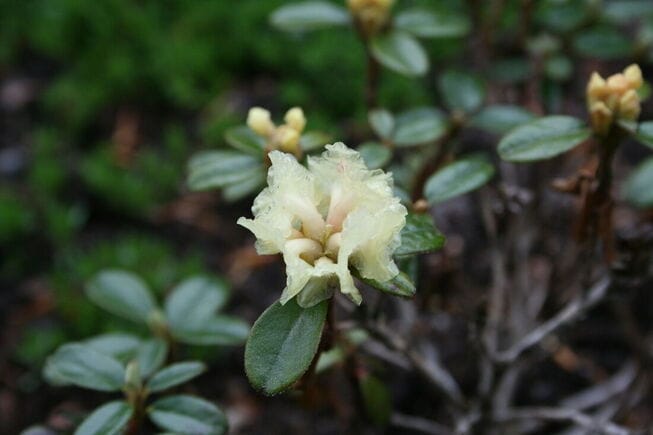Rhododendron anthopogon, Dwa lis, དྭ་ལིསSavoury RhododendronDwa Li (Flower), Ba Lu (Leaf) (Tibetan) Xiao Ye Pi Pa, Lie Xiang Du Juan (TCM) |

|

|
 Rhododendron setosum
Rhododendron setosumThe rhododendrons of Sikkim-Himalaya, Hooker, 1851
 Rhododendron anthopogon subsp. hypenanthum
Rhododendron anthopogon subsp. hypenanthumPhoto by Ulf Eliasson (Wikimedia)
Botanical name:
Rhododendron spp.
Two varieties are used in Tibetan Medicine for Dwa Li:
- Dwa li dkar po (‘White’): R. anthopogon, R. laudandum, R. anthopogonoides, R. cephalanthum
- Dwa li nag po (‘Red’): R. setosum
Rhododendron adamsii is used in Buryat region of Russia.
Rhododendron dahuricum is used similarly.
Parts used:
Flowers, or Leaf and Flower
Temperature & Taste:
Warm, dry. Pungent, Bitter
Classifications:
Q. Stop Cough and Wheezing
Uses:
1. Stops Cough, Clears Phlegm:
-Cough; acute and chronic Bronchitis from Cold Phlegm
-Bronchial Asthma
-Hoarseness
-regarded as strengthening the Lungs
2. Warms the Kidneys, Promotes Urine:
-edema with general swelling, fluid retention associated with Phlegm (flower)
-stiffness and contracture of the limbs
-Coldness of the Kidneys and lower back (Tibet)
-pain of the limbs or waist (Nepal)
-increases strength, promotes longevity
-ethanol extract has demonstrated stimulant properties
-also for Dysmenorrhea and Uterine pain (TCM)
3. Warms the Stomach:
-increases digestive heat, Indigestion, Poor appetite (leaf)
-Stomach Cold, Indigestion, Cold abdominal pain, Vomiting
-Phlegm disorders due to poor digestion
-diseases due to admixture of Heat and Cold
-leaf also warms the Stomach and is used for diseases with Heat and Cold of the Stomach
4. Externally:
-as an errhine to promote sneezing
-in baths to warm the body
-in baths or washes for inflammation of the muscle and sinews
-Hypertension, Paralysis (the herb is put on hot coals and the fumes inhaled in Nepal)
-often used in incense
Dose:
Begin with lower doses and increase as needed.
R: anthopogonoides and R. mucronulatum:
Powder: 500mg–2 grams
Decoction: 6–15 grams
Main Combinations:
1. Bronchitis:
i. Rhododendron anthopogon combine with Licorice and Almond
ii. Rhododendron anthopogon, Tabasheer, Costus, Licorice
2. Edema, Swelling, Cough and Cold with excess Phlegm, Rhododendron anthopogon, Tabasheer, Licorice, Raisin, Costus, Clove, Nutmeg (as in Rhododendron 16 of Tibetan Medicine)
3. Phlegm-Damp disorders due to digestive weakness, Rhododendron anthopogon, Pomegranate fruit, Calcite, Tabasheer, Calcite, Cinnamon, Cardamon, Clove, Nutmeg, Safflower (as in Balancing Comforter of Tibetan Medicine)
4. Rejuvenative medicine, the flower beaten to powder and mixed with milk, curd, butter, sugar, molasses, honey and formed into pills. Said to increase strength, increase lifespan, increase semen and restore white hairs to black. (Norbu)
Major Formulas:
Balancing Comforter
Cowrie Ash 6 (Mgron thal drug pa)
Essence Pills (Bcud len ril bu)
Rhododendron 9 (Dwa li dgu pa)
Rhododendron 18 (Dwa lis bco brgyad)
Settle the Lungs 8 (Glo man brgyad pa) (Tibetan)
Cautions:
1. Avoid overdose.
2. Not used during Pregnancy
3. Use cautiously in the elderly, who are more prone to side effects.
Toxicity:
1. Large doses have been associated with sudden drop in Blood pressure, lowered Heart Rate and arrhythmias.
